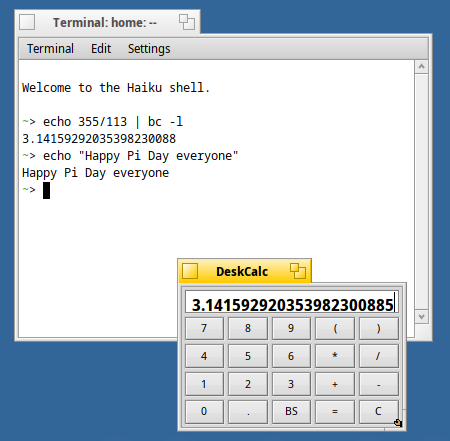Happy Pi Day, everyone! 

… plus an extra retro one too 


(Edited post to correct 22/7 to 355/113)
Happy Pi Day, everyone! 

… plus an extra retro one too 


(Edited post to correct 22/7 to 355/113)
Also thought I’d mention I’d been using 22/7 as a shortcut for pi in my pi posts today… so I’ve been told the value isn’t the real pi but I hope everyone enjoys my posts anyways  (and I see 355/113 comes closer so I’ve updated to that one; thanks everyone!)
(and I see 355/113 comes closer so I’ve updated to that one; thanks everyone!)
alelujah!!11oneone
I thought it’d be fun to try and get an aproximation of pi as a fraction if the days of the year, considering this isn’t a leap year this is what i came up with
365/116 = 3,146551724
Which is sorta close, but still far away.
We always scratch out heads in Europe as 14.3 is not Pi 
Use ISO 8601 date format instead of your made up, silly format.
Or at least do not tell it is european, because there is at least 3 formats used commonly in EU:
I generally write dates in one of two formats these days:
In the UK we tend to use the latter, but when listing dates in programming the ISO style format is the least confusing.
My bad, i meant italian, instead of english.
English unfortunately has no standard. If it did, we would not be having this conversation 
UK we use the / delimiter, but we recognise the German style and we have no problem understanding it, nor the - delimited. What we have issue with is the US style… because it causes only confusion for us. We also generally never speak dates in US format with a few exceptions.
So… you are arguing that it /isnt/ european because europe has severall?
That makes little sense to me, you can always go more specific if you want, but the point was pretty clear, it makes little sense to call it pi day in pretty much any european notation of dates.
Also wierd to claim that it was made up when it clealy is the format used in e.g germany… which you even claim to know to exist.
All of the formats are made up, but some have practical use, others not so much.
They are just as made up as all natural langauge is, you only derive meanig from context. So sure, technically correct. I would agree there. But not that usefull as an assesment imo :)
Many people visits this forum from the americas. I wanted to eliminate the possible misunderstanding that the english/german notation the “european” one.
(I was asked in the US and in Canada, what language we speak in Europe, and they were amazed to hear all the country have different language. They tought we all speak english and or german. This is why i felt it important to point out the possible misunderstanding.)
The problem with ISO standards is that you have to pay to read them. This one in particular costs 158 Swiss Francs (for the base spec, there is a second part with extensions). A bit costly for a standard for date formats, don’t you think?
Also, funnily enough, the Wikipedia page says the usage in France is according to NF Z69-200, but according to the French standardization organism, this has been replaced several times, in 1974, then 1988, and again in 1993. The 1993 version said “we just use EN 28601 which is the same as ISO 8601”. And then in 2011 this one doesn’t exist anymore, it seems both France and Europe are referencing ISO-8601 directly. But still not giving free access to it to their citizens.
The good thing about standards is that there are many to choose from.
Just to address the differences in date format, there is also “Pi Approximation Day”, July 22, which in DD/MM format is written as 22/7 and when viewed as a fraction is equal to 3.142857…, which is a 3 meaning digits approximation of pi. Source: Pi Day.
So, if you usually write date in MM.DD format, you can celebrate 3.14 as Pi Day. If you are more accustomed with DD/MM format, you can celebrate 22/7 as Pi Approximation Day.
I remember that some mathematical functions is related to pi,such as trig functions (my favorite function is the cotangent function) and a function that always takes the role of “Good student from other families” in digital signal processing.
Whereas number Pi is usually associated with trigonometry, it is fundamental constant and also arises in apparently unrelated domains of physics and mathematics.